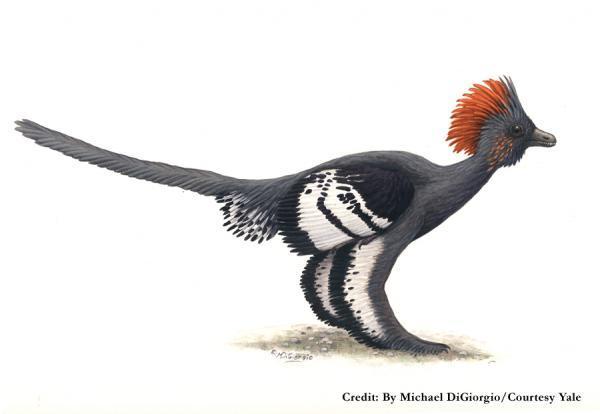Maybe not all the dinosaurs but those of them that flew feathers and became the ancestors of the modern birds were decorated with bright colors like some of today's birds

By deciphering microscopic clues hidden within the fossils, scientists have discovered that a feathered dinosaur that went extinct 150 million years ago wore a variety of very strong colors. This is according to a study by a group of researchers from Yale University that was published in the February 4th issue of the journal Science.
Unlike recently published studies from China that found only two types of melanin pigments in several species of feathered dinosaurs, the new study analyzes color-giving structures called melanosomes from a single fossil of a single animal, allowing the researchers to uncover a rich color pattern of an entire animal. .
In fact, the analysis of the melanosomes performed by the Yale team was so precise that the team was able to associate color with a single feather of Anchiornis huxleyi - a four-winged dinosaur that lived during the late Jurassic period in China. The dinosaur had a rather gray body, a reddish-brown crest, and spots of this color on the face, as well as white feathers on the wings and legs, which also contained prominent black spots. It wasn't a rooster or a sparrow, but the creature was covered in feathers, says Richard Fromm, a professor of ornithology, ecology and evolutionary biology at Yale and co-author of the study. "He would be a most impressive creature if he were alive today."
"The color pattern of the limbs, reminiscent of those of the colorful Hamburg rooster, functioned especially as a means of communication and may have helped them attract mates" suggested Fromm.
The discovery of the use of melanosomes in fossils that changed everything we know about dinosaurs can be attributed to Jacob Winter of the Department of Geology and Geophysics at Yale who discovered these melanosomes in ancient squid fossils. The melanosomes are organelles in the cell that contain melanin - a pigment that absorbs light in animals, including birds. Until now, scientists believed that these dots were the remains of an ancient bacterium. Fromm and his colleagues decided to test Winter's theory about a 112-million-year-old feathered creature from Brazil and a chicken that became extinct 47 million years ago.
And as mentioned in the last study, it was also decided to examine the Anchiornis huxleyi fossil that was recently discovered in the Liaoning province of China. This area was a gold mine for paleontologists, and among other things provided extensive corroboration for the once controversial theory that today's birds are descendants of theropod dinosaurs. The team was also joined by researchers from Beijing University and the Natural History Museum in Beijing who examined the important creature in its own right as a feathered dinosaur. Among others, they received funding from the National Geographic Society and the American National Science Foundation.
The team examined 29 samples from the dinosaur and made precise measurements of the location of the melanosomes within the feathers. The team members also performed statistical analyzes of the amount of melanosomes compared to the amount responsible for colors in birds alive today, and were able to pinpoint the color of a single feather with 90% accuracy and thus were able to create the entire color pattern of the extinct creature. The researchers also reinforced the idea that dinosaurs first developed feathers not for flight but for other purposes. Among other things, to present a color pattern for camouflage or vice versa - "genderization, a feature no less important than developing the ability to fly and improving the aerodynamic ability," added Julia Clark, a member of one of the research groups.
The new discovery also adds insight into the full history of the evolution of feathers in dinosaurs before the origin of modern birds. The study reveals that color patterns in feathers among feathered creatures evolved earlier than previously thought. It is also possible that the feathers were first created for communication purposes.

4 תגובות
Thanks for the comment, corrected.
There are mistakes in translation and typographical and spelling mistakes in this article
Finally and thank God. You only have to think about birds of paradise chirping and kingfishers and realize that if birds use color so extensively, there were also colorful dinosaurs. Now we just need to update the tyrannosaurus feathers to black and white like the eagle and give the iguanas a rainbow of colors like a scout's, I wonder how colorful the quadrupeds were... Hmmm... Great reconstruction of the Anchiornis huxleyi. Great article, yes Yervo, thank you.
of genius.
But how do you know that melanosomes were not used as was done in squids for changing color for example.